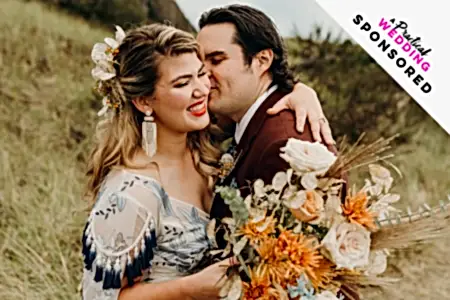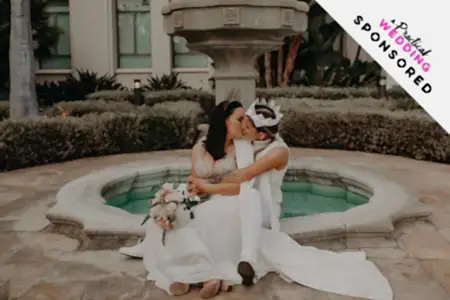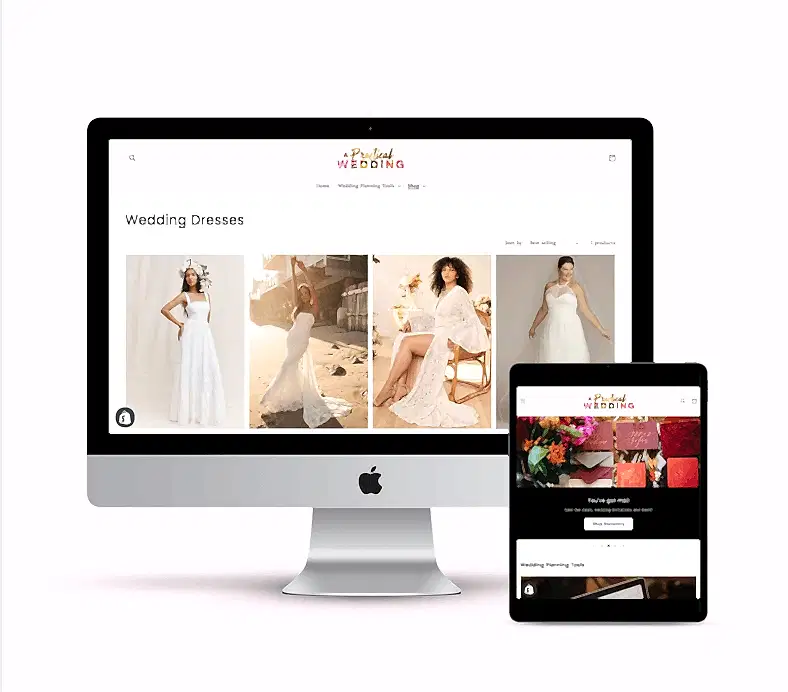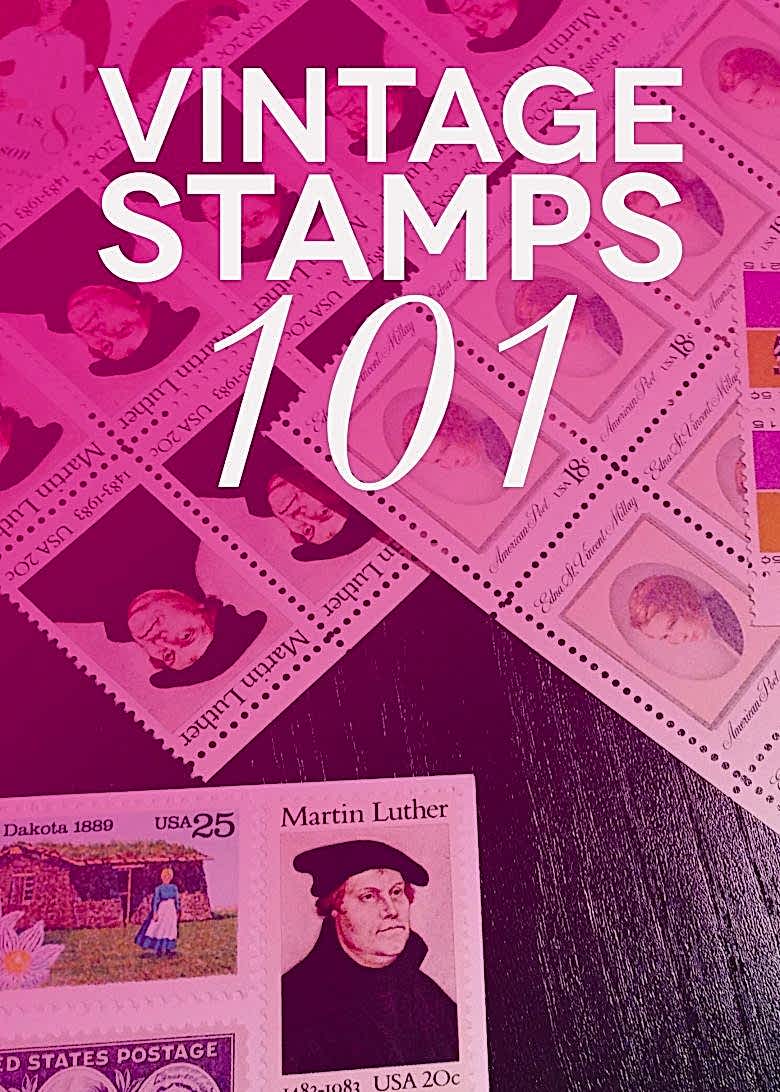
The first time I received a wedding invitation covered with vintage stamps, I was living in the woods in New Hampshire and teaching at the New England Literature Program. As a crucial part of their learning, our students gave up their cell phones and turned in their laptops and spent forty days reading Dickinson and Thoreau, connected to their loved ones only through the United States Postal Service. Mail was king. Our letters and packages were arranged on an old wooden table in the dining hall and, each day after a mad rush to that table for mail, the whole hall would grow silent, absorbed in news from home.
Although Dan’s detailed letters from Ann Arbor were always my favorite, I also loved that wedding invitation. It was a gorgeous, physical artifact, a nod to some other time. Dan and I had not yet talked about getting engaged, but I knew I wanted that look for our own wedding invitations.
When it finally came to time to price procuring my own vintage stamps, we experienced the usual wedding sticker shock. I’d been expecting this: Everything about getting married was at least twice as much as we thought it was going to be. On Etsy, several shop owners will design and organize gorgeous displays of postage, made with your own specifications in mind, but these prearranged stamps were going for about three times the price of normal postage. That wouldn’t have mattered so much, but Dan and I had over a hundred invitations to send out, without a hundred-thousand dollar budget.
I mourned. I looked at the current 70-cent stamps on offer. Bemoaned their modernness. Then hunted around the murky world of eBay to see what I could scrounge up. That’s when I realized: I could do this myself! I could do this cheaper than what I could find elsewhere. The DIY-lightening had struck.
Here’s what I learned striking out on my own:
1. Be ready to do this. By this I mean, spend a weekend at the dining room table, arranging tiny pieces of delicate paper, counting their value in cents, and then glue-sticking them onto envelopes. I wasn’t quite ready. Dan—our resident calligrapher—definitely wasn’t ready. He thought addressing 115 invitations would take three or four hours. It took us fifteen.
2. Give yourself over to an evening of Ebay blur. I’m a terrible, terrible shopper. I worry over each purchase, and might return to the same H&M three times before I’m willing to buy the skirt I keep trying on. (Thank god there’s an H&M every six blocks here in Shanghai.) But I was a damn good stamp purchaser. Choosing stamps was nothing like selecting flowers or a interviewing DJs or committing to a dress. Each choice was small enough to be fun and a very low commitment. I pored over stamp after stamp, with a kind of shopping glee I haven’t experienced in other aspect of wedding planning. Or, frankly, in most aspects of my consumer life.
3. Get to know your stamps. Stamp collecting is the go-to hobby (or used to be), so cliché now as to be a joke. We all know the stamp collector is the epitome of fussiness and obsession, right? Well. Much to my surprise, I freaking loved all the stamps. I loved the satisfying feeling of carefully tearing the perforated edges. I loved all the details, the history. The 1950s and early 60s were the heyday of U.S. postal stamp design. The images are elegant, subtle, sketched. They’re printed in single-color ink, so the stamp is a block of color. They lack the Schoolhouse Rock-ness of the mid-70s stamps (although sometimes you want that mustard and citrus color palate, right?). And they don’t remind me of illustrations my third-grade Elements of Mathematics textbook, like most of the 1980s stamps do. An obvious aspect of these historical artifacts is that they reflect the centralized values of their time period. What did USPS find appropriate to honor? Who was worthy of the stamp? I googled the names of many celebrated (usually white) men. I read about many hard-won battles. I avoided these stamps.
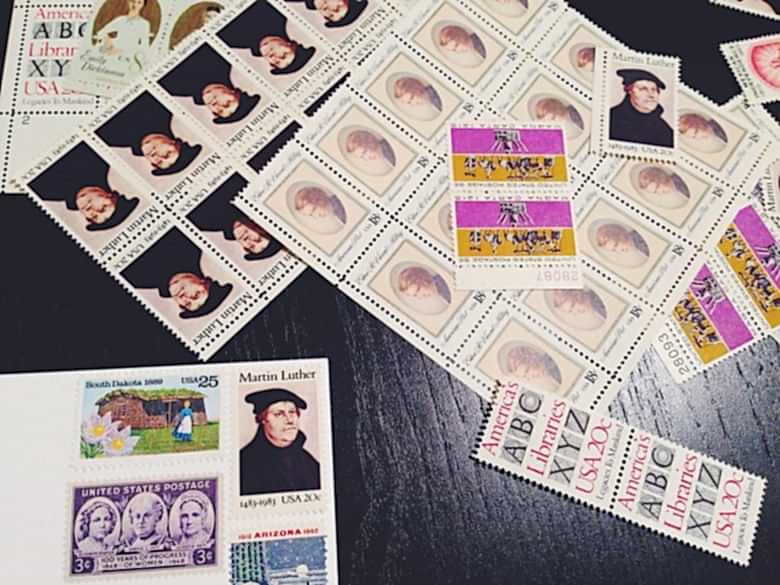
4. To save money, look for sheets of stamps on Ebay marked “@FV +$1” or full value plus one dollar. These are the stamps that are going to allow you to do the vintage look in a lower budget. Essentially, you pay only $1 extra for a full sheet (usually fifty stamps), plus roughly two dollars more for shipping. Say you have fifty invitations to mail, and you choose five different FV+1 stamps. You’ll pay only fifteen dollars more for the vintage stamp look, rather than up to seventy dollars (or more) for the pricier packaged or pre-designed vintage stamp collections. Our own face-value stamps included a 20-cent Martin Luther in his black robe (because I went to Luther College), another “America’s Libraries” stamp with a sheet of text in red and black (because libraries), and a gorgeous three-cent light purple in honor of Joseph Pulitzer (so we could also honor Dan’s time working for the AP).
5. But the stamps you love most might cost you. Emily Dickinson, for example, was a splurge. So were the scarce Mt. Rushmore stamps we bought in honor of its proximity to our venue. Like everything wedding, the more particular you are, the more you’ll probably have to pay. Stores like myvintagepostoffice have stunning collections, but you might pay ten times the value (or more) per stamp. You might also find yourself tempted to splurge. We spent an extra fifteen bucks on a full sheet of four cent 1962 New Mexico stamps, just so we could—one day, if we ever get around to it—frame them and look at them forever, because both Dan and I agreed that they were stunning.
6. You don’t need many. On a regular 5 by 7-inch envelope, you only need four stamps to create the colored mosaic look. The envelope doesn’t need to be plagued with stamps. While we liked the look of six or seven crowded together, I arranged collections of only four stamps that looked perfect, at least to me.
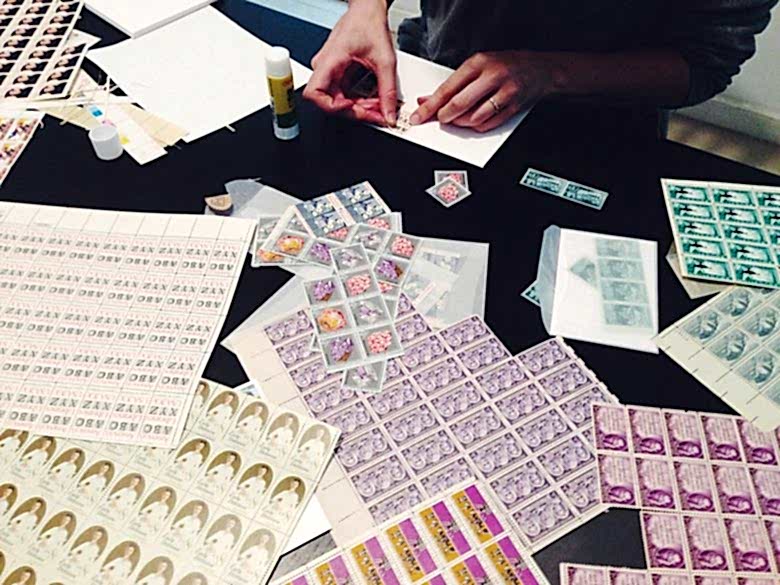
7. Only you care. And that’s OKay. For the first half of our list, I considered each guest and chose stamps in a secret code, a kind of message sent to the receiver. This guest and I met in Michigan, I thought as I affixed a 22-cent Michigan stamp with the silhouette of a pine tree against a sunset. She likes South Dakota and the progress of women. Done. By the end, though, I’d mainly given up on personalization. Gluestick glue had long gathered under all my fingernails. I had become like the previously blind patients Annie Dillard describes in her essay “Seeing.” I now perceived “the world in a dazzle of color patches.”
Late Sunday evening, when my resident calligrapher bewailed the slip of his pen that created “Mew York,” we reminded ourselves—for the tenth time—that no one actually cared one bit about our damn invitations. They’d glance for roughly three seconds at the envelope; they’d miss the secret acknowledgement I’d sent them through my careful stamp arrangement; then they’d read the invitation and toss the thing on their table, where they would find it between two to six weeks later, depending on their housekeeping habits.
8. You don’t have to do any of this. You don’t have to glue a single extra thing if you don’t want to. Just stick a Forever stamp on the envelope and call it a wedding invitation (because it is a wedding invitation). After all, nothing evokes eternal commitment more than a stamp that promises to work until forever or until the USPS crumbles, whichever comes first.
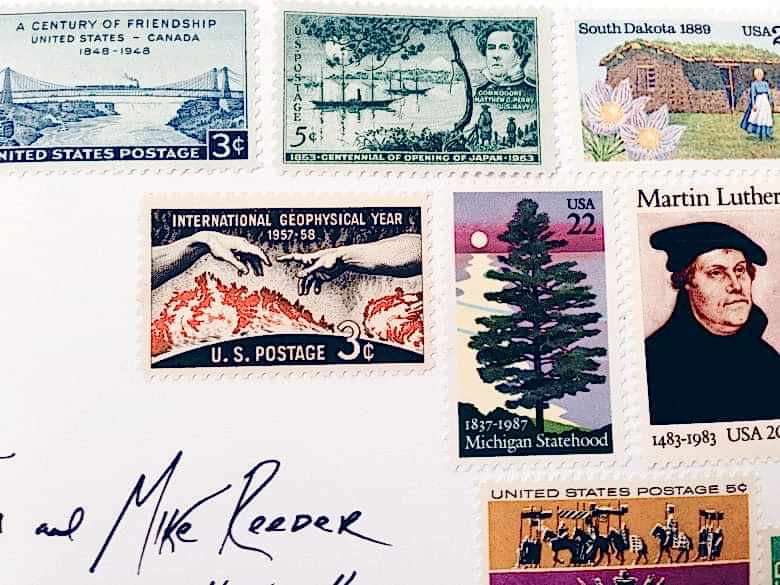
Bonus: The Best Stamps I Didn’t Buy
… But if you do decide that you want to invest your time and energy into a project like this, there’s lots to be excited about. In doing research for this article, I found a banquet of FV+$1 stamps that include the following: a ghostly blue three-cent celebrating the Anapolis Territory Tercentary; another (5-cent) celebrating the same for New Jersey; others honoring collective bargaining, architecture, and the progress of women. If you love Eleanor Roosevelt, you can get Eleanor Roosevelt in a vivid magenta. You can even buy a stamp honoring the pap test. (This displays, unfortunately, not an orchid, but Dr. Papanicolaou with his microscope.) Seriously, what about these Aging Together stamps for your autumn celebration? Because isn’t that point of the whole thing anyway? With luck, you’ll be doing just that.



